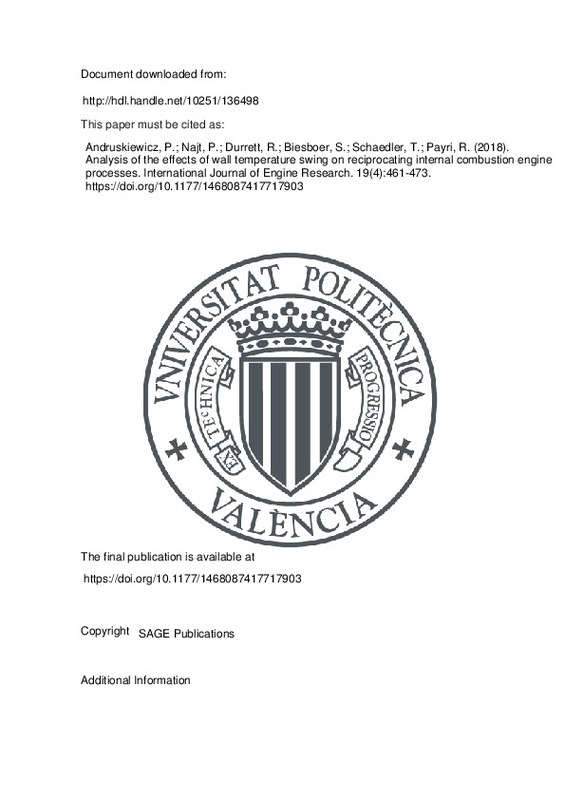JavaScript is disabled for your browser. Some features of this site may not work without it.
Buscar en RiuNet
Listar
Mi cuenta
Estadísticas
Ayuda RiuNet
Admin. UPV
Analysis of the effects of wall temperature swing on reciprocating internal combustion engine processes
Mostrar el registro sencillo del ítem
Ficheros en el ítem
| dc.contributor.author | Andruskiewicz, Peter
|
es_ES |
| dc.contributor.author | Najt, P
|
es_ES |
| dc.contributor.author | Durrett, Russell
|
es_ES |
| dc.contributor.author | Biesboer, S
|
es_ES |
| dc.contributor.author | Schaedler, T
|
es_ES |
| dc.contributor.author | Payri, Raul
|
es_ES |
| dc.date.accessioned | 2020-02-08T21:02:01Z | |
| dc.date.available | 2020-02-08T21:02:01Z | |
| dc.date.issued | 2018 | es_ES |
| dc.identifier.issn | 1468-0874 | es_ES |
| dc.identifier.uri | http://hdl.handle.net/10251/136498 | |
| dc.description.abstract | [EN] A thermal wall temperature swing model was built to capture the transient effects of various material properties and coating layers on the intra-cycle wall temperature of an internal combustion engine. This model was used with a thermodynamic engine simulation to predict and analyze the effects of different types of in-cylinder insulation on engine performance. Coatings that allow the surface temperature to swing in response to the gas' cyclical heat flux enable approximately 1/3 of the energy that was prevented from leaving the gas during expansion to be recovered while improving volumetric efficiency. Reductions in compression work due to better volumetric efficiency and less heat transfer from the walls to the gas accounted for half of the improvements, while additional work extraction during combustion and expansion accounted for the other half. As load increases, the temperature swing and benefits derived from it also increase. NSFC improvements of 0.5% to 1% were seen with a highly swinging coating in the throttled regime for a realistic engine geometry and coating area, up to 2.5% at high loads | es_ES |
| dc.language | Inglés | es_ES |
| dc.publisher | SAGE Publications | es_ES |
| dc.relation.ispartof | International Journal of Engine Research | es_ES |
| dc.rights | Reserva de todos los derechos | es_ES |
| dc.subject | Temperature swing | es_ES |
| dc.subject | Thermal insulation | es_ES |
| dc.subject | Efficiency | es_ES |
| dc.subject | Heat loss | es_ES |
| dc.subject | Heat capacity | es_ES |
| dc.subject | Thermal conductivity | es_ES |
| dc.subject.classification | MAQUINAS Y MOTORES TERMICOS | es_ES |
| dc.title | Analysis of the effects of wall temperature swing on reciprocating internal combustion engine processes | es_ES |
| dc.type | Artículo | es_ES |
| dc.identifier.doi | 10.1177/1468087417717903 | es_ES |
| dc.rights.accessRights | Abierto | es_ES |
| dc.contributor.affiliation | Universitat Politècnica de València. Departamento de Máquinas y Motores Térmicos - Departament de Màquines i Motors Tèrmics | es_ES |
| dc.description.bibliographicCitation | Andruskiewicz, P.; Najt, P.; Durrett, R.; Biesboer, S.; Schaedler, T.; Payri, R. (2018). Analysis of the effects of wall temperature swing on reciprocating internal combustion engine processes. International Journal of Engine Research. 19(4):461-473. https://doi.org/10.1177/1468087417717903 | es_ES |
| dc.description.accrualMethod | S | es_ES |
| dc.relation.publisherversion | https://doi.org/10.1177/1468087417717903 | es_ES |
| dc.description.upvformatpinicio | 461 | es_ES |
| dc.description.upvformatpfin | 473 | es_ES |
| dc.type.version | info:eu-repo/semantics/publishedVersion | es_ES |
| dc.description.volume | 19 | es_ES |
| dc.description.issue | 4 | es_ES |
| dc.relation.pasarela | S\363153 | es_ES |
| dc.description.references | Ramesh Kumar, C., & Nagarajan, G. (2012). Performance and emission characteristics of a low heat rejection spark ignited engine fuelled with E20. Journal of Mechanical Science and Technology, 26(4), 1241-1250. doi:10.1007/s12206-012-0206-0 | es_ES |
| dc.description.references | Hoffman, M. A., Lawler, B. J., Güralp, O. A., Najt, P. M., & Filipi, Z. S. (2014). The impact of a magnesium zirconate thermal barrier coating on homogeneous charge compression ignition operational variability and the formation of combustion chamber deposits. International Journal of Engine Research, 16(8), 968-981. doi:10.1177/1468087414561274 | es_ES |







![[Cerrado]](/themes/UPV/images/candado.png)

